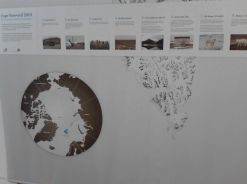What is High Arctic?
High Arctic is an interactive exhibition in situated at the National Maritime Museum.
The exhibition is presented by a collaboration of the National Maritime Museum, United Visual Artists (UVA) and Cape Farewell.
High Arctic is UVA Creative Director Matt Clark's response to his experience of the Arctic as part of Cape Farewell's 2010 expedition. Set in AD2100, in a future where the Arctic environment has changed forever, High Arctic acts as a monument to a lost world. Sounds, light and sculptural forms create an immersive landscape for visitors to explore, conveying the scale, beauty and fragility of today's arctic and encouraging us to question our relationship with the world around us.
My Overview of High Arctic
My initial view of High Arctic was that is was a surreal and confusing experience whereby you are very engaged with the exhibition and this is due to the interactivity of the experience. Information is gained using various senses, the mains one being vision and sound. The use of a UV torch to explore the tall, glacier structures and the interactive surfaces create the sense of information not being presented to you in a traditional way, whereby a sign or piece of information is provided but you have to actually explore and find the information yourself by walking around the exhibition and interacting with the surroundings.
Each of the glacier structures consists of a UV word on the surface, the relevance of these words were initially unclear but after further research I found that they are the names of Svalbard Glaciers which will soon disappear due to climate change. This is more a fun interactive feature rather than informational as you simply shine the UV torch on the surface to reveal the word.
There is also a narrative in the overhead whilst you explore the exhibit and this is the voice of the past, almost begging for humans to make a stand against global warming as the exhibition shows what the outcome will one day be.
There are also four interactive floor surfaces whereby the viewers shine the UV torch at the surface and this will create a movement.





Back